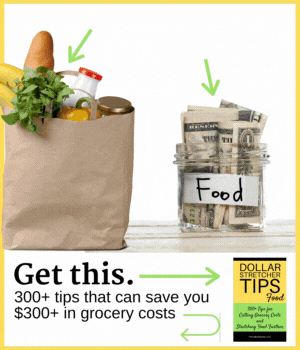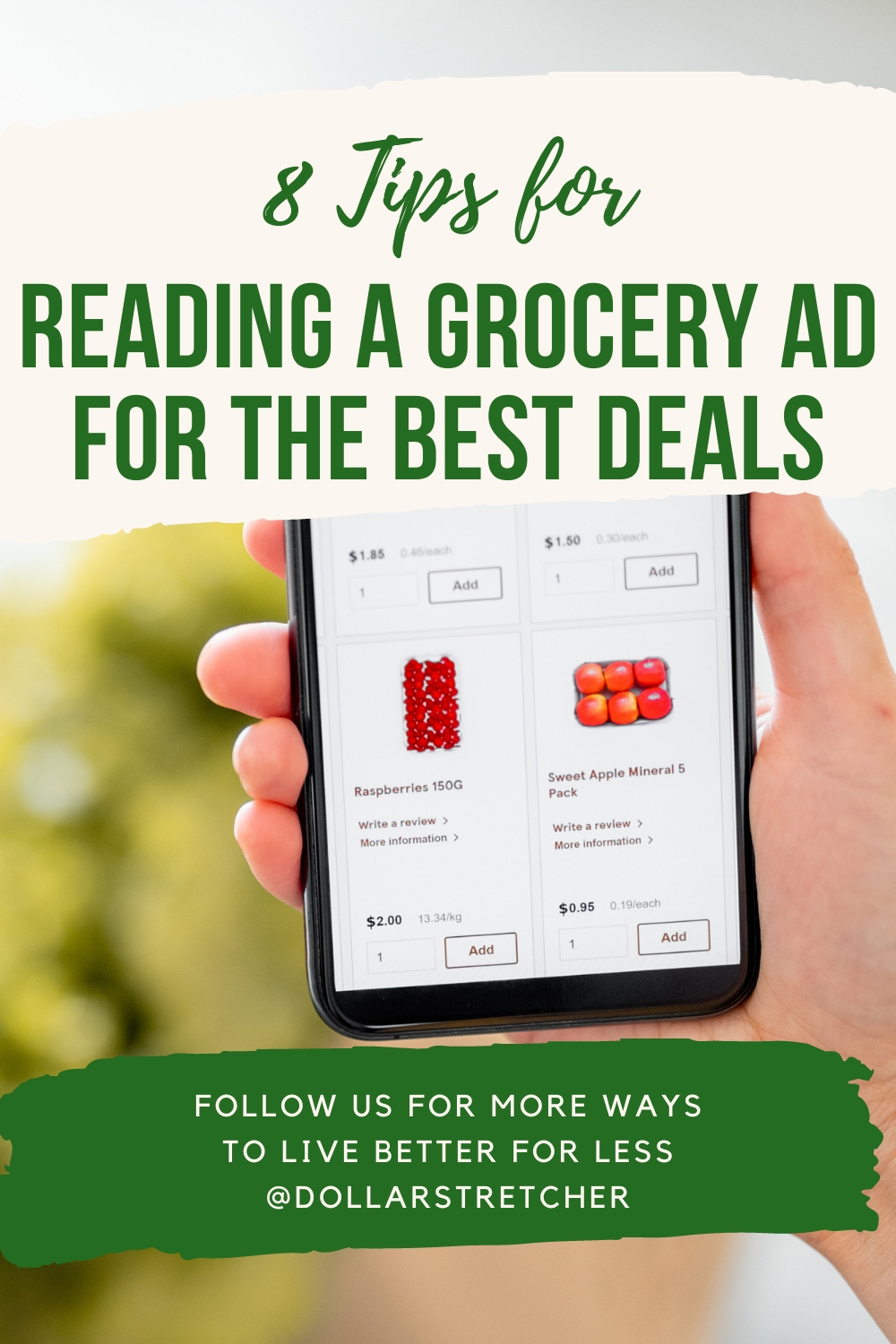How To Read a Grocery Ad To Find the Best Deals: 8 Tips

Want to save more money at the grocery store? A smart place to start is the store’s sales flyer. A grocery marketing expert explains how to read it like an insider to find the best deals.
What used to be affectionately considered the grocery game has become the grocery war.
The drugstore on the corner now sells fresh produce. Grocery stores have apparel sections, and you can pick up an Amazon Echo next to the avocados at Whole Foods.
As more companies battle for your grocery dollars, it has become increasingly confusing to determine how to find the best deals. Most retailers still publish a weekly ad (either in print or online or both), which is reliably the best place to find the best prices each week.
Read on for eight tips on how to read your grocery ads like an insider and save the most money!
1. The best prices are often on the front page.
The real estate adage everyone knows is “location, location, location,” and the same holds true in your weekly grocery ad.
Retailers know that they have to grab consumers’ attention on the front page, or no one will bother looking through the rest of the ad. Therefore, the hottest prices go on the front page. These features are designed to bring you in the door and on which the retailer is often losing money. Pay attention to these features, and if something you buy is on the front page, you likely won’t find a better price by waiting.
Sign Up for Savings
Subscribe to get money-saving content by email that can help you stretch your dollars further.
Twice each week, you'll receive articles and tips that can help you free up and keep more of your hard-earned money, even on the tightest of budgets.
We respect your privacy. Unsubscribe at any time.
2. Pages separate from the circular are the second best place to watch for deals.
If the front page is where the best prices are located, what about the rest of the ad?
Generally speaking, you’ll find great prices on any part of an ad that is separate from the rest of the circular. This includes a cover page that falls completely away, separate pages in the middle that pull out, and extra flaps (called “gates”) that fold over other pages. The deals won’t be as hot as the front page features, but don’t turn your nose up at them! The extremely limited space on the front page means that many great prices are forced onto these “second best” areas at only slightly higher retail prices. Don’t be afraid to stock up because some of them will never make it to the front page at all.
3. Approach the core with caution.
The purpose of a weekly ad is, of course, to bring customers into the store. Unfortunately, retailers have budgets, so they can’t just spend indiscriminately and lose money on every item in the ad. With that in mind, it pays to familiarize yourself with the layout of your favorite grocer’s ad.
You’ll notice a common core that appears every week and doesn’t fall into the other categories mentioned above. These are the areas that you won’t see unless the retailer already has your attention (i.e., inside of the ad), so they effectively don’t have to work as hard to get those items on your list. These are the areas where items are featured at retail that are only slightly reduced or not reduced at all. This doesn’t mean you can’t find great prices in these spaces (sometimes a smaller vendor can’t afford a better feature even with a great price), but it does mean you should be cautious and not assume that you’re saving money just because the item is in the ad.
4. Know which categories are most competitive.
Not all products in the grocery store are created equal, as you no doubt can tell just by the way your local store is laid out. Milk is on everyone’s list, so it is located in the back of the store in hopes you’ll pick up other items during your travels to grab a gallon. This logic also applies to how grocers advertise each week. What does that mean to you? Well, you can count on everyone in town charging about the same for milk, and if they put it on the front page of the ad, it’s not going to be more than a few cents less than the everyday retail.
It’s only going on the front page to get you into the store so they can get the rest of your order. Therefore, if the other features in the ad are no good, then saving a nickel on milk isn’t going to get you very far.
5. Timing is everything.
Just as not all products are created equal, neither is every week on the calendar. While retailers will compete with each other every week, things get really heated during key holidays. You’ll already know that Thanksgiving and Christmas are key weeks, but so are Halloween, Easter, July 4th, and even Valentine’s Day. These are the weeks when grocers really get off their wallets to win your visit, so they invest heavily to get you excited and in the door. In these weeks, the old rules don’t apply and virtually every item in the ad is a great deal. If it’s not perishable, stock up!
6. Read the fine print.
As I’ve mentioned a couple of times in this article, it is extremely common for grocers to advertise an item at a retail price that is below their cost. This only makes good business sense if it is controllable, so it is equally common for there to be fine print associated with these deals. Most retailers have a general price disclaimer at the bottom of their ads, but super-hot features may come with their own.
Here are the most common disclaimers to watch for:
- Limit: Usually this is per household, per transaction. For example, in a $ 1.99-gallon milk ad with a limit of one, the $1.99 retail will only apply to the first gallon purchased in each transaction, with all subsequent gallons ringing up at a higher price.
- Must-buy: These are designed to allow a retailer to put a very attractive retail in the ad while tightly controlling their investment. It is usually used on items where customers normally buy more than one, such as canned soup or fitness bars. In these cases, the hot price only applies if you buy a minimum number of items. For example, you may be able to purchase canned soup for $0.88 when you buy 8 cans. If you don’t buy 8, you don’t get the price. Further confusing the issue is that a must-buy disclaimer can take two forms, including a minimum quantity (buy X or more to get the price) or multiples (buy in multiples of X to get the price). Read carefully to maximize your savings!
7. Know when your grocery store’s sales ad comes out.
Meal planning around what’s on sale is an excellent way to reduce food costs. But you need to be proactive with your planning and make sure you check the sales ads early in the sales cycle rather than at the last minute if you want to save. If your local grocery store starts a new sales cycle each Thursday and you wait until the following Wednesday to check the sales ad, you may not have time to get to the store to shop for those savings.
When do grocery ads come out? It varies by retailer, but many grocery ads come out mid-week. For instance, Publix, a grocer serving the southeastern U.S., runs its weekly sales cycle from Thursday to Wednesday. Every Wednesday, Publix publishes a “sneak peek” of the coming week’s ad online.
8. Compare nearby grocery stores’ ads to find the biggest bargains.
If you live in an area near several grocery chains, it can be worth comparing stores’ weekly sales ads. Walmart or Winn Dixie may have some of the same items on sale as Publix but for a much greater discount.
If you’re wondering how to compare weekly grocery ads, try an app like Flipp that enables you to “flip through” all of the weekly grocery sales flyers for stores in your area.
- 6 Things To Know About Grocery Store Aisles That Can Save You Money
- 10 Things You Can Stop Buying at the Grocery Store
- The Benefits of Grocery Shopping Online (and One Big Drawback)
- Don’t Get Scan Scammed: 6 Tips for Catching Costly Grocery Pricing Errors
- Insider Report: Avoiding Common Costly Grocery Shopping Mistakes
Reviewed January 2024



